|
|
Susanna Åkerman. Christina of Sweden (1626-1689), the Porta Magica and the Italian poets of the Golden and Rosy Cross.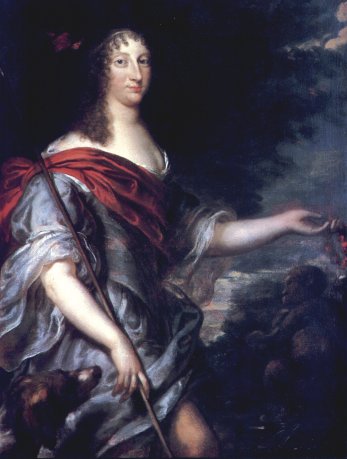 Christina of Sweden (1626-1689),
Christina of Sweden (1626-1689),the Porta Magica and the Italian poets of the Golden and Rosy Cross.
Queen Christina�s practise in alchemy preoccupied her for most of her adult life. Her interest in alchemy also has some intriguing Rosicrucian connections. The original Rosicrucians pamphlets of 1614 spread high expectations for a new age and a universal reformation of the arts and were circulated among radical Paracelsians in Northern Europe. The Rosicrucian elements that were to surface in Italy, however, appear to have grown out of a purely alchemical interest where the transmutational operations promised a future restoration of the "golden age" and was best expressed in poetry. While the royal antiquarian in Stockholm, Johannes Bureus, dedicated Christina a manuscript copy of his speculations on the mystical origin of the Runes, his Adulruna Rediviva, in 1643 and a copy of his apocalyptic work, the Roar of the Northern Lion, in 1644, it is not known whether he showed her his reply to the Rosicrucian Fama, his Fama e Scanzia Redux of 1616. Perhaps influenced by spiritual readings, Christina wanted to institute an Order of Immanuel in 1646, but her advisor Johann Adler Salvius said it would be regarded as child�s play and the idea never materialized. Instead she instituted the Order of the Amaranthe in 1653 with its emblem of an ever green garland signifying immortal life. The amaranth leaves were known by the Greeks to grow in Colchis beyond the Black Sea. She conferred the Order on her Spanish aids who helped her prepare her conversion to Catholicism after her abdication in 1654. She left Sweden and settled in Rome as the convert of the age. Prior to that that, however, Christina had been approached by the alchemist Johannes Franck, who described her future reign as the fulfillment of Paracelsus� prophecy of a return of Helias Artista and of Sendivogius� vision of the the rise of a metallic monarchy of the North. With these visions in store Franck urged on the Queen to start searching for the ruby red powder of the philosophers. He expressed these hopes in the tract that he offered her: Colloquium philosophcum cum diis montanis (Upsala 1651). A year later, in 1652, Christina was offered a text described as "magia cabalistica", by the Hermetic engraver Michel Le Blon, thus mediating the offer of Rabbi Menasseh ben Israel. Le Blon culled a copy of Jacob Boehme�s "little prayer book" from the Behmenist and mystic Abraham van Franckenberg and proceeded to translate it into French while in Stockholm in 1653. Christina was now turning towards Catholicism, but it is possible that she heard of the translation project from Le Blon, who acted as her art curator. At about this time she induced the Greek specialist Johannes Schefferus to write a history of the Pythagoreans, which was published in Sweden a decade later as De natura et constitutione philosophiae Italicae seu pythagoricae (Upsala, 1664). Christina�s preference for Greek manuscripts was critizised by Descartes when he visited Stockholm in 1650. Christina said in reply that she thought his ideas were already formulated by the sceptic Sextus Empiricus and by St. Augustine. She also read a copy of Iamblichus� De mysteriis aegyptiaca, a text that uses Platonic and Hermetic sources in its descriptions of theurgy and divination, methods of coming into contact with gods and demons. In 1656 in Pesaro Christina wrote to the Greek scholar Lucas Holstenius in Rome, who edited Porphyri�s Life of Pythagoras, and revealing her interests said "Platonic works are as rare here as the unicorn." Also, in Pesaro she was greeted in verse by Francesco Maria Santinelli, a fertile poet who was brought into her service. A year later, Santinelli�s brother, Ludovico, was present at Christina�s murder of Monaldescho at Fontainebleau. Francesco Maria was on business in Rome during this infamous event, but was still employed in Christina�s very active scheming. Monaldescho had betrayed the Queen�s French supported plan to again rise to power by a surprise attack on the Spanish rule in Naples. After the scandal of the murder, both brothers had to leave Christina�s court. In 1659, Santinelli wrote a poem, Carlo V, dedicated to emperor Leopold in Vienna . In it, one notes, there is the line "la mia Rosa Croce Aurea fortuna" (V:89). Later in 1666, Santinelli wrote an alchemical poem with commentary, Lux obnubilata suapte natura refulgens, (Light shining forth by it own nature out of darkness) while using the pseudonym Fra Marc�Antonio Crasselame Chinese. In another set of verse, written in 1656 in Rome, by the Marquise Massimiliano Palombara, La Bugia - the second version which now resides in Christina�s collection in the Vatican as Ms. Reginensis Latini 1521 - there is the line "un compagnia intitolata della rosea croce o come altro dicono dell� aurea croce". These scattered remarks add to the evidence that a Rosicrucian identity had developed among alchemists in Italy � an identity that may even be seen as prefiguring the eighteenth century alchemical Gold- und Rosencreutz Orden, made public by Sincerus Renatus (Salomon Richter) in 1710. In 1656, as Mino Gabriele points out, one S. Francesco Melosio performed some verse on la Bugia (the candlelight) in Christina�s Academy with phrases like "la Bugia su l�argento e vera alchimia" (Ms. Barb. Lat. 3885 ff. 85r-88r). Christina thus almost certainly came into contact with poets and alchemists who had taken part of the Rosicrucian expectations. She also came to know some aspects of alchemy and were to collect and practise it. There is a drawing with comments in her own hand that shows some alchemical destillation equipment. Yet, we must remember that the lines on the Rosicrucians in Palombara�s document do not occur in Christina�s version of La Bugia. There is, however, another contemporary French manuscript in her collection called Veritas Hermetica (Ms. Reg. Lat. 1218). This text has a few lines on the gathering of dew and its processing and refers to some Fratres Rores Cocti � brothers of cooked dew. Christina also owned some forty alchemical manuscripts by the foremost medieval authors, as well as practical handbooks. They included works by Geber, Johan Scotus, Arnold de Villa Nova, Raimund Lull, Albertus Magnus, Thomas Aquinas, Benard Trevisano, George Ripley, George Anrach d�Argentine, Johan Grasshof and a Rosarium Philosophorum � with its alchemical imagery of merging the solar-King and the lunar-Queen into a hermaphroditic union. 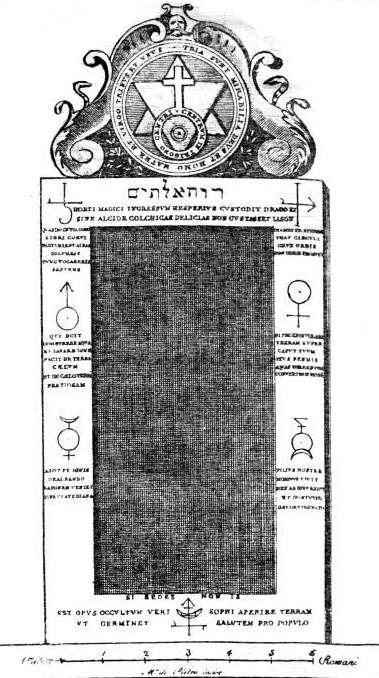
There is also the Porta Magica raised in 1680 in the Roman garden of Palombara which carries a portal stone with an emblem from Henricus Madathanus� alchemical allegory Aureum Seculum Redivivum of 1621. It consists of a cross above a circle in which is inscribed a hexagram with the text "centrum in trigono centri". Mino Gabriele draws attention to the geometrical construction and shows that it is similar to that of the 21st emblem of Michael Maier�s Atalanta Fugiens (Frankfurt 1617) where a man with a pair of compasses is in the process of constructing a hexagram by drawing a triangle within a larger circle while at its base a square is placed within a smaller circle. Palombara�s door is flanked by alchemical insignia and various Latin device describe the alchemical process. The seven signs are taken from Johannes de Monte-Snyder, Commentatio de Pharmaco Catholico (Amsterdam 1666 ) and are in sequence: Saturn-lead, Jupiter-tin, Mars-iron, Venus-bronze, Mercury, Antinomy and Vitriol. The door still stands to be seen on Piazza Vittorio Emanuele in Rome. A legend circulates saying that the door was raised as a commemoration of a successfull transmutation that took place in Christina�s chambers. This version of events was first told in 1804 in an Italian description of Rome in which it is said that northern youth, a "giovane ultramontane," came to Christina�s court and produced some scraps of gold, but that he then disappeared. As we have seen Christina actually owns Palombara�s alchemical manuscript La Bugia and other verse by him. She also accorded him functions in her court and supported his family after his death. Christina was thus Palombara�s patron and this extended to his alchemical poetry. Her "inspiring proximity" and resources were valued also by other literary men. After her death she was elected symbolical head, "Basilissa," of the poets forming the Academia Arcadia, thus continuing her own series of academies held in her palace. The Porta Magica is topped with the Hebrew inscription Ruach Elohim or the Spirit of the Lord and around the emblem is the text: TRIA SUNT MIRABILIA DEUS ET HOMO MATER ET VIRGO TRINUS ET UNUS. In another plate, now lost, was the device VILLAE IANUAM TRANANDO RECLUDENS IASON OBTINET LOCUPLES VELLUS MEDEAE 1680 (Passing by opening the door of the villa, Iason obtained the rich fleece of Medea 1680). Also on the Porta there is an inscription alluding to the travels of the Argonauts: HORTI MAGICI INGRESSUM HESPERIUS CUSTODIT DRACO ET/ SINE ALCIDE COLCHIAS DELICIAS NON GUSTASSET IASON (The hesperian dragon guards the opening of the the magical garden and without Hercules Iason would not have tasted the delicasies of Colchis). From left to right the inscriptions state QUANDO IN TUA DOMO NIGRI CORVI PARTURIENT ALBAS COLUMBAS TUNC VOCABERIS SAPIENS (When in your house black ravens will give birth to white doves, then you are going to be called wise). DIAMETER SPHAERAE THAU CIRCULI CRUX ORBIS NON ORBIS PROSUNT (The diameter of the sphere, the tau of the circle, the cross of the globe, are of no use to the world). QUI SCIT COMBURERE AQUA ET LAVARE IGNE FACIT DE TERRA CAELUM ET DE CAELO TERRAM PRETIOSAM (He who knows how to burn with water and wash with fire makes out of the earth heaven and out of the heaven precious earth). SI FECERIS VOLARE TERRAM SUPER CAPUT TUUM EIUS PENNIS AQUAS TORRENTUM CONVERTES IN PETRAM (If you will throw the earth over your head with its hair you will convert into stone the torrents of water). AZOTH ET IGNIS DEALBANDO LATONAM VENIET SINE VESTE DIANA (When azoth and fire whitens Latona, Diana will come without clothes). FILIUS NOSTER MORTUS VIVIT REX AB IGNE REDIT ET CONIUGO GAUDET OCCULTO (Our dead son lives, the king turns from the fire and takes pleasure in the occult conjunction). EST OPUS OCCULTUM VERI SOPHI APERIRE TERRAM UT GERMINET SALUTEM PRO POPULO (It is the occult work of the true sapients to open the earth in order to generate salvation for the people). On the threshold there is the short line which can be read both ways: SI SEDES NON IS (If you sit you cannot go, if you don�t sit go). In the same year, 1680, a tract was published at Ulm by Johannes de Monte Hermetis with the title: Explicatio Centri in Trigono Centri per Somnium � Das ist: Erläuterung dess Hermetischen Güldenen Fluss. The text contains five parts, first an Aenigma Cabalisticum, then the explicatio centri in trigono centri and then two alchemical commentaries on the operations in the Opus Philosophicum written by "dem Löwen dess Rothen Creutzes". Last was a text on astronomical medicine, on how to cure illness through the mediation of the stars. The explicatio describes the merging of the upward and downward triangles representing philosophical fire and philosophical water and is contemporary with the raising of the Porta Magica but, disappointingly, it does not shed further light on Palombara�s initiative. 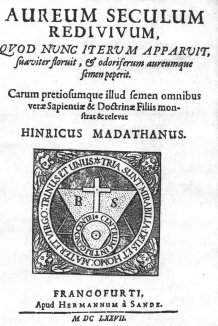
Henricus Madathanus� Aureum Seculum Redivivum is suggestive in Christina's case because it describes various women sages such as Rachel and Leah, and a queenly figure that performs various roles in the text. (See the accompaning text The Golden Age Restored). Significantly, Madhatanus ends the text by saying that he is a "frater aurae crucis". In 1625 it was reprinted both in a separate edition and in the Musaeum Hermeticum by Lucas Jennis, who also printed Michael Maier�s Rosicrucian works. The emblem was taken over by Wienner von Sonnenfels in 1747 in his Splendor lucis, oder Glanz des Lichts published at Vienna. Madathanus� lower part of the emblem, "centrum in trigono centri", was reproduced in the well known work that circulated in the Gold- und Rosencreutz Orden, the Geheime Figuren der Rosencreutzer (Altona 1785-88). 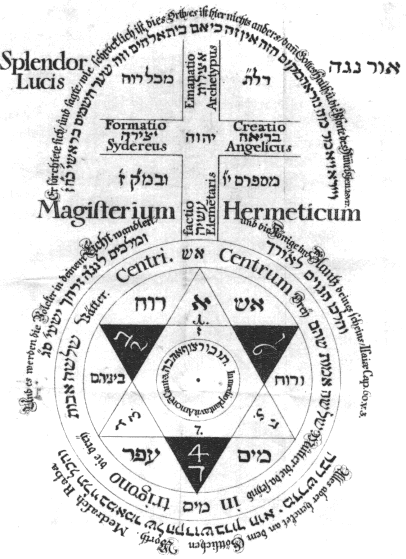
There is no evidence to determine exactly when Christina started with alchemy, but her involvement tended to increase toward the end of her life. In the summer of 1667 in Hamburg, Christina experimented with the messianic prophet and alchemist Giuseppe Francesco Borri, but Cardinal Azzolino wrote her that she had to distance herself from Borri because he was searched by the inquisition. Christina at this time also corresponded with another alchemist, Johan Rudolf Glauber. She also took interest in the phosphorus discovered by Hennig Brandt. In her collecion of spiritual medieval manuscripts, counting to over 2000 items, are included texts by Joachim di Fiore and Campanella. Also on the list is a copy of the Hermetic Asclepius. Her collection includes Trithemius� Steganographia (Ms. Reg. Lat. 1344) and John Dee�s Monas Hieroglyphica (Ms. Reg. Lat. 1266). She also owned parts of a Picatrix and a Latin version of the Sefer-ha-Raziel (Ms. Reg. Lat. 1300), a book of angelic magic. Her collection of printed books counted to several thousand items and included Paracelsus� works, alchemical works of Johannes Theurneisser and Andreas Libavius . In 1655, she gave a large collection of alchemical manuscripts from Prague to her librarian Isaac Vossius. These were once owned by Rudolph II and are written in the German, Czech and Latin languages, a collection which now resides as the Codices Vossiani Chymici at the University of Leiden. Christina�s books are listed in a document now in the Bodleian library, Oxford. It is prefaced by a drawing of a rose in full bloom with the text "Erst einen Knop danach einen Rosen." The corresponding list in the Vatican (Ms. Vat. Lat. 8171) carries a Bible, drawn by the same hand, with a bee and a spider with the text "Mel ibit tibi fel", i. e. the honey will go to your bitterness � emblems that combined remind us of Robert Fludd�s bee-adorned rose and cob-web of the Summum Bonum, but that perhaps may indicate a more mainstream mysticism. 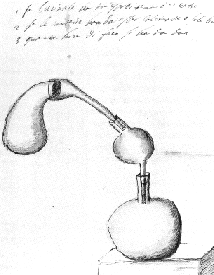
Christina was very eager to know more of alchemy and brought in a younger woman called Sibylla into the experiments. She also employed a working alchemist, Pietro Antonio Bandiera, to run her laboratory and finally testamented him the equipment. An alchemical tract was dedicated to her by Giovanni Batista Comastri, the Specchio della Verita (Venice, 1683). There is a document in her own hand, entitled "Il laboratorio filosofico � paradossi chimici," but it appears to be notes from a text with the same title. The last text that Christina read, found by her deathbed in 1689, was a letter on the universal medicine, the alkahest, by Samuel Forberger. Was Christina perhaps an adept involved in Palombara�s closest circle, or was she merely a patron full of curiosity? She clearly was a very forceful woman. She claimed that her mind was entirely masculine and that she lacked what she saw as the normal faults of womanhood. This belief was to materialize in her ardent hope for a real transmutation. In her collection of papers that she testamented to Cardinal Azzolino, now in Riksarkivet, Stockholm, there is an Italian text on which Chrisina has written that it was given to her in April 1682. In it, Christina�s abdication and travel to Rome is first described. Suddenly, in one sentence, it is said "la natura perfettera l�opera" and instead a strong youth by name Alexander appears. The text goes on to tell of Alexander�s future travel to Constantinople to convert the Turks. Since she as ex-Queen took the name Christina Alexandra in Rome, it appears that the prophecy with its wonderful metamorphosis spoke to Christina�s inner dreams of perfecting herself. In this the Aristotelian view of women as undeveloped men had a role to play, but also the alchemical vision of polarities and ultimate perfection. Yet, we may have some doubts of her expertise. In a letter to Azzolino in Hamburg in March 1667 she writes of the report of a successful transmutation performed by a Dutch peasant. The learned doctor Helvetius, who formerly had been sceptical towards alchemy was present and now guaranteed its fulfillment. Christina adds that with one grain of the projection powder one is able to convert "500 livres" of lead, that is 250 kg, into 24 carats of gold. This is far out of proportion as the tradition teaches us that the real weights is perhaps one grain to 15 g of gold. She does not say that the result was obtained through a multiplication process. Maybe she grew to learn more, especially after meeting Borri and after setting up her own laboratory in Rome. Christina knew something of alchemy, we may infer, and we may rest with one of her maxims where she says: "la Chimie est une belle science. Elle est l�anatomie de la nature et la veritable clef qui ouvre tous les tresors. Elle donne la richesse, la santé, la gloire et la veritable sagesse a son posseseur." She added that while alchemy had recently been degraded by charlatans, it remained as the royal science. True to her Platonic ideals she had medals made as a gift to her visitors. It carried a shining sun on one side and with the text on the other: "Nec falso, nec alieno � with neither false nor borrowed /light/." This was how she liked to present herself : i. e. as a philsopher-Queen. The philosophy involved was not the modern rationalism of Descartes but the age-old philosophia perennis and the theory of alchemical transmutation. Literature:Susanna Åkerman, Queen Christina of Sweden and her Circle: The Transformation of a Philosophical Libertine. Brill, Leiden 1991. Susanna Åkerman, Rose Cross Over the Baltic: The Spread of Rosicrucianism in Northern Europe. Brill, Leiden 1998. Jeanne Bignami Odier and Anna Maria Partini, "Cristina di Svezia e le scienze occulte" Physis 1983, pp. 251-278. P. C. Van Boeren, Codices Vossiani Chymici. Leiden 1975. Eugène Canseliet, Deux Logis Alchimique: En marge de la science et de l�histoire. Pauvert, Paris 1979 (1945). Giovanni Batista Comastri, Specchio della Verita � dedicata alla Regina Cristina di Svezia, Venezia 1683. A cura di Anna Maria Partini. Edizione Mediterranee, Rome 1989. Johannes Franck, Alkemiska skrifter: Hermetiska teser om den filosofiska stenens grundläggande principer. Utg. Carl-Michael Edenborg. Philosophiska förlaget, Stockholm 1992. Mino Gabriele, Il giardino di Hermes: Massimiliano Palombara alchimista e rosacroce nella Roma del Seicento. (Con la prima edizione del codice autografo della Bugia � 1656). Editrice Ianua, Rome 1986. Kjell Lekeby, "Drottning Kristinas gudomliga metamorfos. Från intersexualitet till mansblivande" Fenix 1997:2. Marchese Massimiliano Palombara, La Bugia: Rime ermetiche e altri scritti. Da un Codice Reginense del sec. XVII. A cura di Anna Maria Partini. Edizione Mediterranee, Rome 1983. La Porta Magica: Luoghi e memorie nel giardino di piazza Vittorio. A cura di Nicoletta Cardano. Fratelli Palombi Editori, Rome 1990. Francesco Maria Santinelli, Sonetti Alchimici e altri scritti inediti. A cura di Anna Maria Partini. Edizione Mediterranee, Rome 1985. Arne Wettermark "Christine de Suède et la science des roys: Quelques maximes a la lumiere de la tradition hemetique." Nouvelles de la Republique des lettres 1990:2 pp. 61-82. |